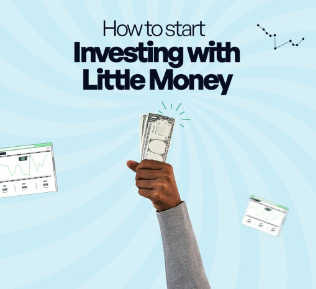How to Start Investing With Little Money
Think you need thousands of dollars to start investing? Think again. One of the biggest myths about investing is that it’s only for the wealthy. The truth is, you can start investing with just a few dollars thanks to technology, fractional shares, and low-cost investment platforms.
In this beginner-friendly post, we’ll walk you through how to start investing with little money, step by step.
Why Start Now, Even With a Small Amount?
Even small investments can grow significantly over time thanks to compound interest. Waiting until you have “more money” often means missing out on valuable time in the market.
“The best time to plant a tree was 20 years ago. The second-best time is today.” — Chinese Proverb
Step 1: Set Clear Financial Goals
Before you invest a single naira or dollar, ask yourself:
-
Are you investing for retirement, a house, or wealth building?
-
Do you need access to your money soon, or can you let it grow long-term?
-
How much risk are you comfortable taking?
Your goals will determine the best type of investment for you.
Step 2: Build an Emergency Fund First
If you don’t already have one, start with a small emergency fund (e.g., $300–$1,000). Investing is for long-term growth your emergency fund is for life’s surprises.
Step 3: Choose the Right Investment Platform
Many modern platforms make it easy to start investing with very little money. Look for platforms that offer:
-
No or low minimum investment
-
Low fees
-
Fractional shares (so you can buy a piece of expensive stocks)
-
Automatic investing or robo-advisors
Popular beginner-friendly apps:
-
Acorns – Rounds up your spare change and invests it
-
Robinhood – No trading fees, fractional shares
-
Fidelity / Vanguard – Trusted firms with low-cost index funds
-
Chaka / Trove (for Nigerian investors) – Local access to U.S. stocks
Step 4: Start Small but Stay Consistent
You don’t need a lump sum to begin. Even $5 to $50 per week can grow over time. The key is consistency.
Set up automatic transfers to your investment account—this helps you invest regularly without thinking about it.
Step 5: Pick the Right Investment Options
With limited funds, here are some great starter investments:
✅ Index Funds / ETFs
-
Low-cost
-
Diversified (spread across many companies)
-
Perfect for beginners
✅ Fractional Shares
-
Buy a portion of a company’s stock (e.g., Apple or Tesla)
-
Great if a full share is too expensive
✅ Robo-Advisors
-
Automated portfolios tailored to your risk level
-
No experience needed
✅ High-Yield Savings / Money Market Accounts
-
Not for high growth, but safe and liquid
-
Good place to park cash while you plan
Step 6: Keep Learning and Avoid These Mistakes
❌ Don’t Chase “Get-Rich-Quick” Schemes
If it sounds too good to be true, it usually is.
❌ Don’t Invest Without Understanding the Basics
Even small investments deserve a bit of research. Know what you’re investing in.
✅ Do Track Your Progress
Use free apps or spreadsheets to watch your money grow and stay motivated.
Real-Life Example
Let’s say you invest $50 per month in an index fund earning an average of 8% annually.
After:
-
5 years: ~$3,700
-
10 years: ~$8,000
-
20 years: ~$24,000
Not bad for just $1.60 per day!
Final Thoughts
You don’t need to be rich to start investing—you just need to start. The earlier and more consistently you begin, the more your money can grow.
Whether you’re a student, a side hustler, or someone rebuilding your finances, you can begin today with what you have. Your future self will thank you.


